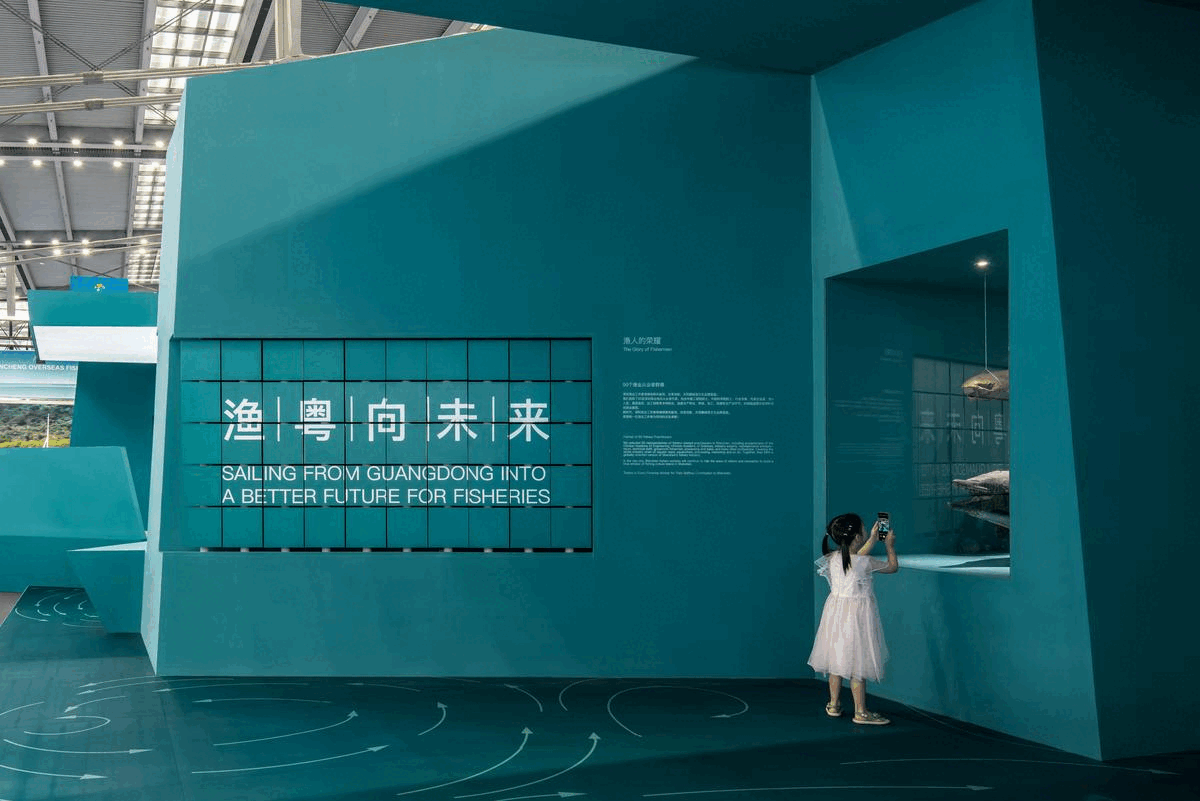Shenzhen International Fisheries & Seafood Expo Fisheries Development Planning and Construction Exhibition Curation and Space Design
Shenzhen International Fisheries & Seafood Expo 2023 (hereinafter referred to as “Shenzhen Fisheries Expo” ) was held in Hall 1 of Shenzhen Exhibition Center (Futian) from May 11 to 13, which is a high-profile global fisheries event. PILLS principal architect Zigeng Wang was invited to be the chief curator and designer of the exhibition. PILLS was responsible for the exhibition curation and space design, Architectural Design & Research Institute Tsinghua University Co., Ltd was responsible for the content, and Shanghai Fengyuzhu Culture Technology Co., Ltd was responsible for the construction. The three teams join hands to challenge traditional trade fair design and present the blueprint of Shenzhen fisheries in a panoramic view with museum standards. Hundreds of Bustling Barges Float The exhibition design extracts the visual characteristics of “Hundreds of Bustling Barges Float,” outlining the magnificent momentum of boats moving incessantly and staggeringly. “A hundred boats are competing for the first one” implies the positive meaning of striving for the head and evokes the poetic association of “eagle striking the long sky and fish flying in the shallow bottom.” It also implies the harmonious coexistence of human beings and all things in the ocean. The concept design of the plan is a tribute to the development history of “Farming and Fishing” in Shenzhen for generations, expressing the pioneer spirit of Shenzhen to build a modern and international marine fishery city with high-quality development. Meanwhile, it echoes the theme of this year's Fishery Expo, Sailing from Guangdong into a Better Future for Fisheries. The walls are designed with the reference of a seaside reef, shaped into a jagged form through the shuttle-shaped walls and sloping booths. The wall edges are clear and sharp as if to recreate the hitting waves' dynamics, with the ocean's power contained. The walls and booths are lined up in planes to form a natural spatial enclosure, separating four thematic exhibition areas. The walls of each exhibition area support larger pieces of lintel stones on the top, which are connected or inserted into each other, forming a majestic, solemn, and elegant “megalith” as a whole. We chose blue and green (Teal) as the main colors, symbolizing the boundless ocean and the diffusion film on the ceiling to create a mysterious and tranquil space mood with fluidity. Visitors can get a bird's eye view of the area's exterior and then immerse themselves in the interior of the exhibition hall by walking down from both sides of the second-floor platform (main entrance). The graphic design of the ground is derived from the illustration of the ocean currents distribution, and the arrows indicating the movement of seawater converge into the circulation path of the exhibition, leading people to start a journey of oceanic wandering. The exhibition consists of four chapters: “Farming at Sea in Great Tide,” “Ecological Sustainability,” “Go to the Deep Blue,” and “Shenzhen in the Future.” Through dozens of representative physical exhibits, video works, and multimedia interactive installations, the exhibition will lead people to explore how Shenzhen has transformed from a small fishing village to a modern fishing capital, creating a new immersive fishery cultural experience. At the same time, with the platform of the first Shenzhen International Fisheries & Seafood Expo, the exhibition aims further to stimulate fishery-related practitioners and other members of the public to pay attention to marine ecology and the“Big Food Concept,” looking forward to a sustainable deep blue future jointly. 01_Farming at Sea in Great Tide The two prehistoric sea invasions and retreats created a unique terrain in the Shenzhen area, building the natural background of the fishing city development. The ancient people relied on the sea to build a city and demanded land from the sea, shaping the characteristic water township pattern of the Pearl River Delta. Taking the formation of the delta landscape as the starting point of the narrative, the exhibition extracts the coastline of Shenzhen on a plane and transforms it into a visual spine of historical illustration. Born in the sea and flourished by fishing, Shenzhen's nearly 7,000 years of urban development history unfolds like a scroll along the timeline. We supplemented the corridor with water ripple lighting facilities. The projection of waves extends from the floor to the ceiling, forming an integrated spatial atmosphere. On the opposite side of the timeline exhibition wall, a bright and narrow display case draws the viewer's attention to the collection of ancient fishing gear and historical photographs. The screen next to the niche contains documentary films on the culture of the boat-dwelling people and pearl picking in Dongshan, which vividly tell the historical stories about the fishing industry behind the exhibits. Farming at Sea in Great Tide shows the past and present life of the fishing town through material slices and media in multiple dimensions and evokes the common memory of local people in the fishing town. The specimens of aquatic animals collected by the Shenzhen Institute of Guangdong Ocean University are suspended and displayed in an integrated niche. With the cooperation of ambient lighting, the beautiful and diverse aquatic creatures present a visual feast for the audience. These specimens are of great scientific value and artistic masterpieces that show the wonders and charms of life in the water world. Visitors can enter the Digital Oceanic Sea of Shenzhen at the end of the passage. A combination of projection and mirrors creates an immersive experience space, with the projection images drawn in the ancient sea-creatures style that continues the museum aesthetics. Illustrations of Shenzhen's local coral, fish, algae, shellfish, and other creatures pop out and migrate around the visitor. The space has a “periscope,” where people can enjoy the nation's first live streaming of the non-stop underwater program 365 days under the sea in Shenzhen. The real underwater scenes and the digital ocean complement each other, bringing visitors a unique experience of interweaving the material and virtual worlds, empowering traditional art with modern technology. 02_Ecological Sustainability Shenzhen was born into the sea, and marine ecology is the basis of modern fisheries. The issues of industrial development and environmental protection go hand in hand. The second exhibition area aims to emphasize the ecological protection measures related to fisheries and restore the ecological model of the underwater home. On one side of the exhibition hall, we use a large map to visualize the legal policies of the Shenzhen Bay fishing ban area and the South China Sea fishing moratorium. Rare specimens of wild aquatic animals such as red coral and nautilus forfeited by customs are exhibited, highlighting the green contribution of fisheries planning and related enforcement actions to the development of Shenzhen. The exhibition joins hands with Ocean University to exhibit a 2.4m large coral tank where visitors can enjoy rare live corals under professional lighting equipment at zero distance. In the same interface, we present the national key protected aquatic species through light boxes to educate the public about the importance of stocking measures to restore ecological diversity. The Artificial Reef is an infrastructure to improve the ecology of the sea and provide a habitat for aquatic organisms to gather. The exhibition restores its design details with high-precision models and places them on top of the contours of the plane, suggesting the geomorphology of the seabed, creating a new landscape of a different and colorful underwater home. The deep blue world brings the viewer the experience of being in the secret realm of deep water. The exhibition will bring visitors a deep water experience. 03_Go to the Deep Blue Sea The third exhibition area takes the comprehensive fishery industry chain from the sea to the table as the narrative clue. The exhibition content starts from multiple angles, such as seed breeding, equipment manufacturing, and breeding vessels, and then extends to fishery science and technology innovation, fishery brand building and culture inheritance, etc., depicting the whole process map of modern fishery development in Shenzhen through a multi-media medium. The design plan combines graphic planes and multimedia films to show the new highland of the “Blue Seed Industry” development in the upper reaches of the industry; the models of modern fishery breeding vessels and ancient fishing boats are placed together within the market size wireframe, and the contrast of the model volume highlights the importance of technological progress for the Marine Granary in the new era. The exhibition selected four benchmark projects for display, and visitors can both read the relevant graphic introduction through the electronic photo album embedded in the wall map and look down at the three-dimensional model of the marine pasture above the exhibition table for corresponding interpretation. The “Land-Port-Island-Sea” linkage development pattern is transformed into a viewable and readable exhibit, leading to a beautiful vision of a Co-prosperity of Fishery and Shenzhen. In promoting the high-quality development of modern fisheries, Shenzhen has launched the Zhenpin standard system to regulate the quality of aquatic products strictly. During the Fishery Expo, 100 kinds of products that passed the Zhenpin assessment were publicly presented for the first time in the form of light box picture arrays, and various forms of aquatic products from the ocean to the table were activated by the exhibition, which was fascinating. Visitors can also check the detailed information on the relevant Zhenpin through the interactive screen and experience the new connotation of Pengcheng fishing culture in depth. From a distance, the exhibition hall's façade, with the booth model in the foreground and the lightbox and graphic façade in the middle and far view, forms a rich visual hierarchy, showing a deeper depth in the relatively limited space of the exhibition hall. 04_Shenzhen in the Future The concluding exhibition area first presented visitors with the top-level design interpretation of the Trinity Suggestions & Policy & Planning and the planning blueprint of the fishery industry layout, which conveyed the policy document more clearly and vividly to the public. At the same time, a fun and interactive fish painting screen was set up to leave ample space for viewers to imagine the future of fisheries. In the final chapter, the exhibition returns to the social dimension of sustainable development, expressing tribute and gratitude to the people working on the sea and fishery. We have designed a rotating wall of portraits, each of which is a delicate three-sided portrait and story of a relevant person, including grassroots fishermen, technicians, academicians from the Chinese Academy of Engineering, the Chinese Academy of Sciences, industry experts, representative entrepreneurs and other practitioners in various positions. They are the writers of the history of fisheries in Pengcheng and the helmsmen who will lead the future of fisheries to ride the waves. The images gathered in this international fishery fair convey the power of cohesion and hope. “Hundreds of Bustling Barges Float.” After more than forty years of rapid development, Shenzhen has gone through the course that other cities have taken hundreds of years to complete and has transformed and upgraded from a perceived small fishing village to a model for modern fisheries management reform in China. The Shenzhen Fishery Development and Construction Planning Exhibition starts from the origin through the immersive overall space design and diversified, innovative exhibition methods, showing the audience the grand blueprint of building an innovative and sustainable modern fishery capital and conveying the development concept of a fishing city supported by science and technology, with culture as the soul. This is the beginning of the future of Guangdong Fishery.
Project Information Exhibition Name: Shenzhen Fisheries Development Planning and Construction Exhibition Exhibition Period: 5/11/2023-5/13/2023 Exhibition Location: Hall 1, Shenzhen Convention and Exhibition Center Organizer: Planning and Natural Resources Bureau of Shenzhen Municipality Curator & Leader Designer: Zigeng Wang Design Team: PILLS / Yuxin Tian, Hongyi Du, Xingzhu Jiang, Enica Deng, Skyler Huang Content Planning: Architectural Design & Research Institute Tsinghua University Co., Ltd / Lianzhi Ren, Mao Li, Zhining Cai, Ranqi Zheng, Xiaotong Wang, Yelin Zhang, Xian Liu Constructor: Shanghai Fengyuzhu Culture Technology Co., Ltd.



















